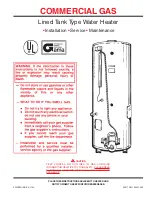
8
In venting systems where a continuous or intermittent back
(positive) draft is found to exist, the cause must be determined
and corrected. In some cases, a special vent cap may be
required.
Do not install this unit on the positive draft side of a venting system
being served by a power exhauster.
DRAIN VALVE AND ACCESS PANELS
The heaters are equipped with a 3/4" drain valve mounted above
and to the left of the burner. See page 2.
The combustion chamber observation access panel is located
above and to the left of the burner. A plug located under the
panel, see fig. 5, is inserted into the combustion chamber wall.
This plug should not be removed except, in rare cases, when the
combustion chamber requires cleaning or replacement.
WARNING
DO NOT REMOVE THIS PLUG WHILE THE HEATER IS IN
OPERATION. THE COMBUSTION CHAMBER IS UNDER
PRESSURE AND MAIN BURNER FLAMES WILL ESCAPE
THROUGH THE OPENING. THIS IS AN EXTREMELY
HAZARDOUS CONDITION WHICH MAY RESULT IN SERIOUS
INJURY.
COMBUSTION CHAMBER ACCESS PORT
FIGURE 5
IMPORTANT
Before removing the access panel and observation plug, BE SURE
THAT THE ELECTRICAL POWER TO THE HEATER IS “OFF”.
This will prevent the heater from operating while servicing the
unit. Remember to install the plug and access cover BEFORE
restoring electrical power to the heater.
Another access panel is located above and to the right of the
burner, fig. 6. This panel covers the cleanout opening in the tank
which is sealed by a gasket and cover.
TANK CLEANOUT PORT
FIGURE 6
Occasionally, some water seepage will occur at a cleanout port.
To correct this situation, slightly tighten the cleanout cover bolts
until the seepage is eliminated. Do not overly tighten the bolts or
the cleanout gasket will be damaged. Tighten each bolt gradually
and alternate between opposed bolts on the cleanout cover.
BURNER INSTALLATION
Remove the factory-installed insulation covering the combustion
chamber opening. (A utility knife is useful for cutting out the
insulation). Cut the insulation back even with the jacket opening.
Install the flange gasket (which is usually taped to the heater
jacket) over the three bolts protruding from the tank at the
combustion chamber opening.
Remove the hardware (3 hex nuts, 3 flat washers, and 3 lock
washers) from the shipping bag attached to the heater’s electrical
conduit.
POWER BURNER INSTALLATION
FIGURE 7
Begin assembling the power burner to the tank by placing the
power burner nozzle in the combustion chamber opening. Slide
the nozzle into the tank and rotate the mounting flange to engage
the mounting bolts, refer to Figure 7. Then, place the flat washers
followed by the lock washers, and finally the hex nuts on the
mounting bolts. Hand tighten the nuts. Then gradually tighten
each nut alternating between the 3 mounting bolts. Do not over
tighten as damage to the flange gasket or to the tank may result.
Refer to figure 7.
GAS METER SIZE — CITY GASES ONLY
Be sure that the gas meter has sufficient capacity to supply the
full-rated gas input of the water heater as well as the
requirements of all other gas fired equipment supplied by the
meter. If gas meter is too small, request the gas company to
install a larger meter having adequate capacity.
GAS PRESSURE REGULATION
Main manual pressure to the water heater should be between
4.5" minimum and 10.5" maximum w.c. for natural gas and 11.0"
minimum and 13.0" maximum w.c. for propane gas. The inlet
gas pressure must not exceed the maximum value. A service
regulator is necessary if higher gas pressures are encountered.
See Table 6.









































